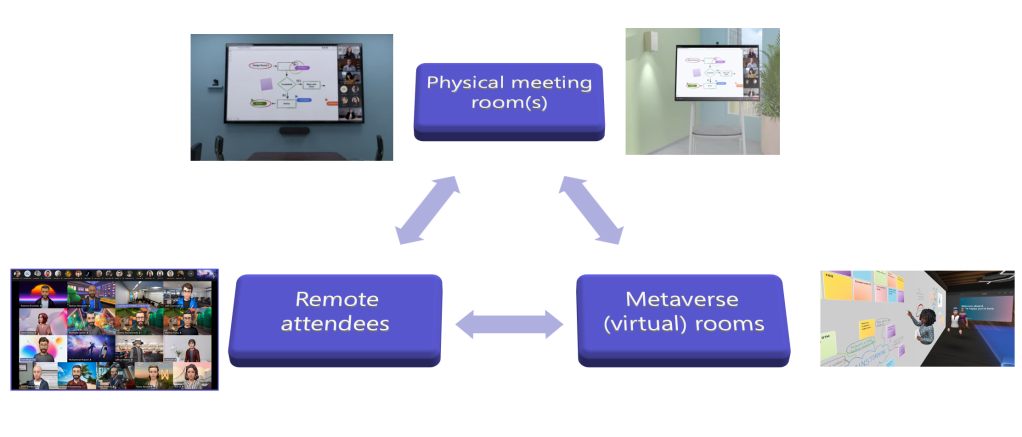Microsoft Whiteboard is under a lots of development and evolves in a fast pace. Despite some step backs, like rollback of the new desktop client last year, it is going forward and extending it’s usability beyond being “replicant of physical world whiteboard”. In fact it has already done it and I want to state it out loud: Microsoft Whiteboard is already a Microsoft Metaverse tool. Yes, that is right: When using Microsoft Whiteboard you are already using a Metaverse.
What makes Microsoft Whiteboard a Metaverse tool?
Think about the metaverse : embedding real world with a virtual one and the other way around. What happens in the real world are reflected back to the virtual world. And what happens in the virtual world are reflected back to the physical world.
In a sense, the Metaverse enables us to embed computing into the real world and to embed the real world into computing, bringing real presence to any digital space.
Satya Nadella
Many of us have been using Microsoft Whiteboard via the app, via web version, mobile client and of course in Teams meetings. Some of people have had the pleasure to also work with Whiteboard using Surface Hub. With the new Whiteboard version everyone can use any of these client to work together at the same time, on the same board.
This means that if you have a meeting room setup that
- Has Microsoft Teams Rooms device (MTR)
- and a Surface Hub in the room.
It is possible to configure coordinated meetings in a way that Surface Hub always opens Whiteboard when the MTR is joining a meeting. That is why it is important to consider how your meeting room is set up. MTR is great for showing video and other content, while Surface Hub excels when you want people to interact with content. This open a scenario where people in the physical meeting room can choose to use Surface Hub to use the whiteboard – or they can use it from their own devices if you don’t want to step up. This alone is a great step forward where everyone in the room (and in other rooms & online) can see the same result at the same time. I just have to point out that inking with a pen to Surface Hub.. It is a great experience. Personally I prefer it any day over a physical flip/whiteboard.
Let’s put out minds back to the scenario. We have the physical meeting room with Microsoft Teams Room device and Surface Hub set up. Other attendees in the meeting can be remote attendees using Teams, Surface Hubs or other Teams Rooms with or without Surface Hubs. This will be the de facto meeting in the future (Hybrid era).
When people are using Whiteboard to ink in their ideas, designs, tasks, comments and so on:
- When remote attendees (persons or people in other rooms) ink to their Whiteboard it is displayed live via Surface Hub to attendees physically in meeting rooms and also in every other attendees devices (Whiteboards)
- When people in the physical room ink to the Whiteboard using Surface Hub it is displayed live in every other rooms’ and attendees Whiteboard –> it is being displayed to everyone else attending the meeting.
- In the future when we are working in Mesh for Teams space and there is a Whiteboard this same whiteboard would be displaying the same view as in every other participant’s whiteboards do. And any changes done in the metaverse whiteboard would be reflected back to every attendees; including those Surface Hubs in physical rooms. Keep on reading, there is more about this later in the post.

In the new Whiteboard version it has also the feature called “Collaborative cursors” that shows where in the board other attendees are working on it. Across boundaries of real and virtual worlds.
This is why Whiteboard is already a Microsoft Metaverse tool. It connects physical world with the digital one. It is a kind of digital twin that is present both in reality and metaverse and it is synchronizing it’s content across boundaries.
The new new Whiteboard desktop version is scheduled for February 2022.
Whiteboard in the Immersive Metaverse
Immersive Metaverse is the 3D meeting experience using Mesh for Microsoft Teams. In Ignite 2021 keynote and sessions we saw how Whiteboard was used in the immersive Metaverse as well – this will of course make it feel more “immersive and real” for other attendees in the meeting as well: the same Whiteboard can be edited in physical and virtual spaces and also via remote attendees or other clients at the same time.
What I really enjoy in this is that virtual attendees can choose to be in the immersive metaverse together, while every physical room attendees are in their physical meeting rooms together: everyone can collaborate together and results are being displayed via the Whiteboard. Is this the far future? No! Mesh for Teams has been declared to preview H1/2022, so my guess is summer 2022. Will the Whiteboard be included in the space right away? I hope so, but of course we don’t know until we get our hands onto to a preview. My guess is that this year (2022) we will have this scenario up and living, making Teams Rooms and Surface Hubs key to Hybrid meetings setup and Microsoft Whiteboard will have a big advantage over various other Whiteboard apps – at least until they also can be added to Mesh Metaverse spaces.

Microsoft Loop adds even more
When the support for Microsoft Loop components is added to Microsoft Whiteboard it will take an another huge leap in the Metaverse. In fact Whiteboard will be a very key tool that will get a big time usage in Microsoft Metaverse, including immersive Metaverse. It will enable creation of content together and place the same loop to multiple locations or applications – and they all sync their changes all the time. In the immersive metaverse – and perhaps in the meeting room also – you may not be able to use a keyboard. This is why speech to text is becoming more and more important. Perhaps we see the scifi act become reality sooner than later: people using speech to dictate a document or message, and AI is smart enough to make it truly usable. Dictation is already there in Microsoft Word, for example, and for some it works really well. I will write an more in-depth post about speech to text and voice user interface later to this blog.
What will be cool about Microsoft Loop is that the same component can be manifested in various locations: Teams chats (already out!), emails, documents like Word and PowerPoint, OneNote and also in the Whiteboard. People co-creating content in Teams chat or Word would be reflected into the Whiteboard instantly – and thus to those physical meeting rooms via Surface Hub Whiteboards. And it doesn’t stop there, because you will be able to bring in content from business systems as well, using Loop technology to add – for example – Dynamics CRM Opportunity or SAP record there. Microsoft stated at Ignite 2021 that there will be more details and info how to build your own Loop interface at Build 2022. This will open up possibility to bring in details (that you can co-author and edit ) from line-of-business systems – or even from Digital Twins. This Looped Future is very awesome, if you ask me.


4 thoughts on “Microsoft Whiteboard is already part of the Metaverse”